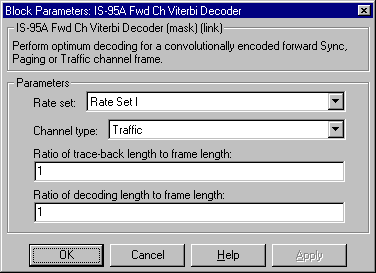| CDMA Reference Blockset |
  |
IS-95A Fwd Ch Viterbi Decoder
Decode a convolutionally encoded information sequence optimally
Library
IS-95A Mobile Station Receiver
Description

This block uses the Viterbi algorithm to optimally decode a frame of convolutionally encoded information. The Viterbi algorithm searches through the trellis, as defined by the encoder, for the most probable sequence and outputs the decoded data along with the metric for the final detected path. The decoder operates in continuous and noncontinuous operation modes.
Continuous operation mode applies to the Sync and Paging channels. In this mode, the decoder will not be initialized to an all-zero state between frames of input data. This operation mode will not introduce any processing delay whenever the frame length is a multiple of the decode length. Otherwise, there will be a processing delay of one frame.
Noncontinuous operation mode applies to the Traffic channel. In this mode, the decoder initializes to an all-zero state value prior to processing each input frame. As a result, this operation mode does not introduce any processing delay. Note that in the noncontinuous operation mode, the decoder starts the traceback in the zero state. This means that the last 8 bits of the sequence being decoded must be 0.
The input frame port size is equal to the maximum possible size of 576 (Rate Set II, Traffic Full Rate). As the table below shows, the number of relevant input symbols applied to the Viterbi decoder, however, depends on the channel type, rate set, and rate. Similarly, the output port frame size is the maximum possible size of 288 (Rate Set II, Traffic Full Rate). The table below also gives the number of relevant output bits for different channel types, rate sets and rates. Valid bits start from the beginning of a frame. The block ignores input bits beyond the relevant bits, and sets output bits beyond the relevant bits to zero.
Channel Type
|
Number of Relevant Input Bits
|
Number of Relevant Output Bits
|
Sync
|
64
|
32
|
Paging, Full Rate
|
384
|
192
|
Paging, Half Rate
|
192
|
96
|
Traffic, Rate Set I, Full Rate
|
384
|
192
|
Traffic, Rate Set I, Half Rate
|
192
|
96
|
Traffic, Rate Set I, Quarter Rate
|
96
|
48
|
Traffic, Rate Set I, Eighth Rate
|
48
|
24
|
Traffic, Rate Set II, Full Rate
|
576
|
288
|
Traffic, Rate Set II, Half Rate
|
288
|
144
|
Traffic, Rate Set II, Quarter Rate
|
144
|
72
|
Traffic, Rate Set II, Eighth Rate
|
72
|
36
|
Inputs
- Rate
- Integer scalar that specifies the data rate for the input signal. To indicate a rate fraction of Full, Half, Quarter, or Eighth, use an input value of 0, 1, 2, or 3, respectively. The table below shows all valid channel types and rate fractions, along with their associated data rates and Rate input values.
Channel Type
|
Data Rate (bps)
|
Rate Input Value
|
Sync (always Eighth rate)
|
1200
|
3
|
Paging, Full
|
9600
|
0
|
Paging, Half
|
4800
|
1
|
Access (always Half rate)
|
4800
|
1
|
Traffic, Rate Set I, Full
|
9600
|
0
|
Traffic, Rate Set I, Half
|
4800
|
1
|
Traffic, Rate Set I, Quarter
|
2400
|
2
|
Traffic, Rate Set I, Eighth
|
1200
|
3
|
Traffic, Rate Set II, Full
|
14400
|
0
|
Traffic, Rate Set II, Half
|
7200
|
1
|
Traffic, Rate Set II, Quarter
|
3600
|
2
|
Traffic, Rate Set II, Eighth
|
1800
|
3
|
- Frame In
- Real vector of size 576 representing the input frame to be decoded.
Outputs
- Frame Out
- Binary vector of size 288 representing the decoded frame.
- Metric
- Real scalar representing the final path metric of the Viterbi decoder.
Dialog Box

Parameters
- Rate set
- The rate set, either Rate Set I or Rate Set II.
- Channel type
- The channel type, either Sync, Paging, or Traffic.
- Ratio of trace-back length to frame length
- Real scalar that specifies the maximum number of bits traced back in the trellis structure as a fraction of the frame length. The maximum value is one. If the product of this ratio and the frame length is not an integer, then the product is truncated to an integer.
- Ratio of decoding length to frame length
- Real scalar that specifies the number of bits decoded in a traceback operation as a fraction of the frame length. If the product of this ratio and the frame length is not an integer, then the product is truncated to an integer. The ratio of decoding length to frame length should be less than or equal to the ratio of traceback length to frame length. When the decoding length is less than the traceback length, the decoded bits are the last bits traced back.
See Also
IS-95A Fwd Ch Convolutional Encoder
IS-95A Rev Ch Convolutional Encoder
IS-95A Rev Ch Viterbi Decoder
IS-95A Forward Traffic Channel Codec Demo
 | IS-95A Fwd Ch Scrambler | | IS-95A Long Code Generator |  |






